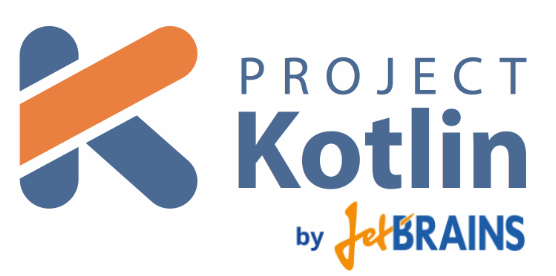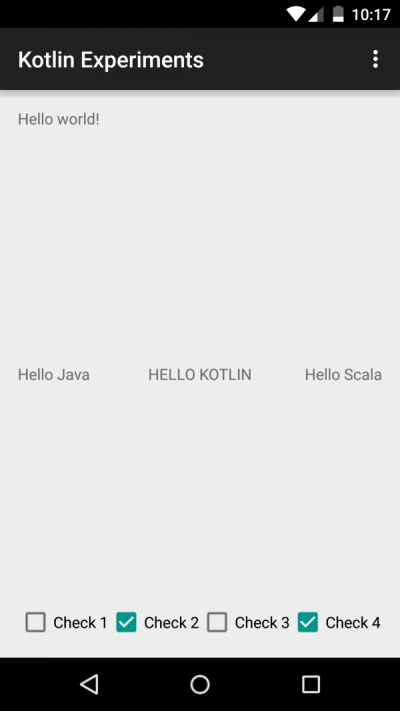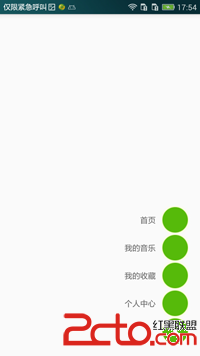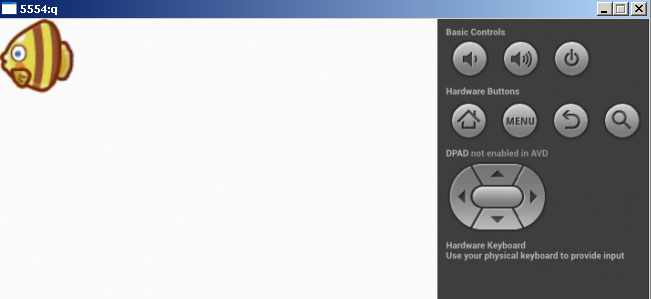編輯:關於android開發
原文標題:Functional operations over Views in ViewGroup using Kotlin
原文鏈接:http://antonioleiva.com/functional-operations-viewgroup-kotlin/
原文作者:Antonio Leiva(http://antonioleiva.com/about/)
原文發布:2015-07-29

集合、迭代、數組、序列 ... 所有這些共用一套好用的函數,這組函數可幫助對它們的元素進行轉換、排序以及其它操作。但是,由於類的構造方法,在Android SDK中,有部分函數還不能用。
例如,我們不能直接獲得ViewGroup內部視圖列表,所以這些操作是不可能使用的。但是並非所有一切都失去了。在Kotlin中,我們有方法為這些操作准備任何數據。訣竅簡單:我們只需要創建一個Sequence。在我們的例子中,Sequence將是一組有序的View。我們只需要實現一個函數,其返回Iterator。
如果我們有了Sequence,函數式操作領域就為我們打開了使用它們的大門。所以讓我們從它開始。
如lakedaemon666在評論中所建議的那樣,有一個不用Sequence的更簡單的方法可以獲得同樣的結果。我會保留原文記錄,但是建議你看看替代的解決方案。
如前所述,我們將創建迭代器(iterator),它必須知道是否有下一項,下一項是哪個。我們還創建一個擴展函數,為了任何 ViewGroup 和繼承類提供一個簡單的方法做那項工作:
1 fun ViewGroup.asSequence(): Sequence<View> = object : Sequence<View> {
2
3 override fun iterator(): Iterator<View> = object : Iterator<View> {
4 private var nextValue: View? = null
5 private var done = false
6 private var position: Int = 0
7
8 override public fun hasNext(): Boolean {
9 if (nextValue == null && !done) {
10 nextValue = getChildAt(position)
11 position++
12 if (nextValue == null) done = true
13 }
14 return nextValue != null
15 }
16
17 override fun next(): View {
18 if (!hasNext()) {
19 throw NoSuchElementException()
20 }
21 val answer = nextValue
22 nextValue = null
23 return answer!!
24 }
25 }
26 }
獲得一個視圖列表,並對其進行函數操作是非常有用的。因此,我們可以先創建頂層視圖列表,然後,用它以遞歸方式逐級檢索ViewGroup中視圖。
讓我們為ViewGroup創建新擴展屬性。擴展屬性非常類似擴展函數,可用於任何類:
1 public val ViewGroup.views: List<View> 2 get() = asSequence().toList()
我們可以用這,創建遞歸函數,它返回布局中任何ViewGroup內部的所有View:
1 public val ViewGroup.viewsRecursive: List<View>
2 get() = views flatMap {
3 when (it) {
4 is ViewGroup -> it.viewsRecursive
5 else -> listOf(it)
6 }
7 }
用flatMap,我們把全部結果的多個列表轉換到一個列表中。它將遍歷任何視圖;如果是ViewGroup,它還會遍歷自己的視圖。否則,就返回僅有一項的列表。
現在,我們得到viewRecursive屬性,執行我們想要的任何操作。這裡你可以看到兩個例子。我創建這樣一個簡單的布局:
1 <RelativeLayout xmlns:android="http://schemas.android.com/apk/res/android"
2 xmlns:tools="http://schemas.android.com/tools"
3 android:id="@+id/container"
4 android:layout_width="match_parent"
5 android:layout_height="match_parent"
6 android:paddingBottom="@dimen/activity_vertical_margin"
7 android:paddingLeft="@dimen/activity_horizontal_margin"
8 android:paddingRight="@dimen/activity_horizontal_margin"
9 android:paddingTop="@dimen/activity_vertical_margin"
10 tools:context=".MainActivity">
11
12 <TextView
13 android:layout_width="wrap_content"
14 android:layout_height="wrap_content"
15 android:text="@string/hello_world"/>
16
17 <FrameLayout
18 android:layout_width="match_parent"
19 android:layout_height="wrap_content"
20 android:layout_centerInParent="true">
21
22 <TextView
23 android:layout_width="wrap_content"
24 android:layout_height="wrap_content"
25 android:text="Hello Java"/>
26
27 <TextView
28 android:layout_width="wrap_content"
29 android:layout_height="wrap_content"
30 android:layout_gravity="center_horizontal"
31 android:text="Hello Kotlin"/>
32
33 <TextView
34 android:layout_width="wrap_content"
35 android:layout_height="wrap_content"
36 android:layout_gravity="end"
37 android:text="Hello Scala"/>
38
39 </FrameLayout>
40
41 <LinearLayout
42 android:layout_width="match_parent"
43 android:layout_height="wrap_content"
44 android:layout_alignParentBottom="true"
45 android:orientation="horizontal">
46
47 <CheckBox
48 android:layout_width="wrap_content"
49 android:layout_height="wrap_content"
50 android:text="Check 1"/>
51
52 <CheckBox
53 android:layout_width="wrap_content"
54 android:layout_height="wrap_content"
55 android:text="Check 2"/>
56
57 <CheckBox
58 android:layout_width="wrap_content"
59 android:layout_height="wrap_content"
60 android:text="Check 3"/>
61
62 <CheckBox
63 android:layout_width="wrap_content"
64 android:layout_height="wrap_content"
65 android:text="Check 4"/>
66
67 </LinearLayout>
68
69 </RelativeLayout>
例如,在MainActivity.onCreate()中,可應用這段代碼。它將Hello Kotlin!串轉換為大寫字母,選中偶數復選框:
1 val container: ViewGroup = find(R.id.container)
2 val views = container.viewsRecursive
3
4 // Set Kotlin TextView to Upper
5 val kotlinText = views.first {
6 it is TextView && it.text.toString().contains("Kotlin")
7 } as TextView
8 kotlinText.text = kotlinText.text.toString().toUpperCase()
9
10 // Set even checkboxes as checked, and odd as unchecked
11 views filter {
12 it is CheckBox
13 } forEach {
14 with(it as CheckBox) {
15 val number = text.toString().removePrefix("Check ").toInt()
16 setChecked(number % 2 == 0)
17 }
18 }

如lakedaemon666在評論中所提及的那樣(謝謝解釋),如果之後我們遍歷整個sequence,那麼創建sequence就沒有什麼意義了。例如,當按行讀取文件時,sequence是懶惰迭代。只有要求必要的項目。而我們卻要使用所有項,所以簡單的列表就足夠了。
另外,有許多簡單的方法可以產生視圖列表。我們可以依賴值域產生視圖的索引列表,將它們映射到我們需要的視圖列表中。所有這一切就一行:
1 public val ViewGroup.views: List<View>
2 get() = (0..getChildCount() - 1) map { getChildAt(it) }
這是個無聊的例子,但是這個概念或許可使你的所有代碼函數化,停止依靠那些典型迭代式編程的循環和其它控制流。
記住從我寫的書《Android開發者的Kotlin》中,你能夠學習到Kotlin的這點以及許多其它能力,你將通過從0開始創建Android APP學習Kotlin。
 仿Android印象筆記底部導航欄
仿Android印象筆記底部導航欄
仿Android印象筆記底部導航欄 最近用上了印象筆記,覺得android 版的底部導航欄挺不錯的,好多應用裡面都有用到,想著自己動手實現一下,不多說,先上圖:
 Drawable Animation 幀動畫,drawableanimation
Drawable Animation 幀動畫,drawableanimation
Drawable Animation 幀動畫,drawableanimationMySurfaceView類: package com.fm; import andr
 Android中使用RecyclerView和CardView實現瀑布流效果(StaggeredGrid)
Android中使用RecyclerView和CardView實現瀑布流效果(StaggeredGrid)
Android中使用RecyclerView和CardView實現瀑布流效果(StaggeredGrid) 在Android 5.0 中引入了Material Des
 RxJava 和 RxAndroid 四(RxBinding的使用),rxjavarxandroid
RxJava 和 RxAndroid 四(RxBinding的使用),rxjavarxandroid
RxJava 和 RxAndroid 四(RxBinding的使用),rxjavarxandroid 對Rxjava不熟悉的同學可以先看我之前寫的幾篇文章 RxJava